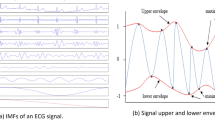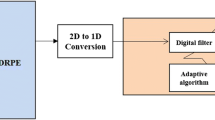Abstract
Biometrics are widely deployed in various security systems; however, they have drawbacks in the form of leakage or stealing, therefore numerous solutions have been proposed to secure biometric template such as cancelable biometric, which is one of the possible solutions for canceling and securing biometric template. However, this problem is still open and to the best of our knowledge, few previous studies have proposed a complete authentic system using the cancelable biometric techniques based on electrocardiogram (ECG). In this paper, we have applied two cancelable biometric techniques for developing a human authentication system based on ECG signals. The first one is an improved Bio-Hashing and the second one is matrix operation technique. The improved Bio-Hash technique solves the problem of accuracy loss, which is the main drawback of basic Bio-Hash technique. The protected feature vector (Bio-Hashed code) is generated from the inner product between the ECG features matrix and tokenize number matrix. While the matrix operation technique is applied on the ECG feature matrix to produce a transformed template which is irreversible to the original features of the ECG. In the authentication stage, Feed-Forward Neural Network (FFNN) is used to verify individuals. After applying the two cancelable techniques on three public available ECG databases, experimental results show that the proposed system performs better regarding authentication and outperforms state-of-the-art techniques considered.
















Similar content being viewed by others
References
Albert A (1972) Regression and the moore-penrose pseudoinverse. Academic Press, New York
Ang R, Safavi-Naini R, McAven LF (2005) Cancelable key-based fingerprint templates. In: Boyd C, Gonzalez Nieto JM (eds) Australasian Conference on Information Security and Privacy. Springer, Germany, pp 242–252
Bolle RM, Connell JH, Ratha NK (2002) Biometric perils and patches. Pattern Recogn 35(12):2727–2738
Connie T, Teoh A, Goh M, Ngo D (2005) Palmhashing: a novel approach for cancelable biometrics. Inf Process Lett 93(1):1–5
Da Silva HP, Lourenço A, Fred A, Raposo N, Aires-de Sousa M (2014) Check your biosignals here: A new dataset for off-the-person ECG biometrics. Comput Methods Prog Biomed 113(2):503–514
Damer N, Opel A, Nouak A (2013). Performance anchored score normalization for multi-biometric fusion. In: International Symposium on Visual Computing, Springer, pp. 68-75
Dey N, Nandi B, Dey M, Biswas D, Das A, Chaudhuri SS (2013) BioHash code generation from electrocardiogram features. In: IEEE 3rd International Advance Computing Conference (IACC). IEEE, Ghaziabad
Dey M, Dey N, Mahata SK, Chakraborty S, Acharjee S, Das A (2014) Electrocardiogram feature based inter-human biometric authentication system. In: International Conference on Electronic Systems, Signal Processing and Computing Technologies. IEEE, Nagpur, pp 300–304
El-Khamy SE, Korany NO, El-Sherif MH (2017) A security enhanced robust audio steganography algorithm for image hiding using sample comparison in discrete wavelet transform domain and rsa encryption. Multimedia Tools and Applications 76(22):24091–24106
Goldberger AL, Amaral LAN, Glass L, Hausdorff JM, Ivanov PC, Mark RG et al (2000) Physiobank, physiotoolkit, and physionet components of a new research resource for complex physiologic signals. Circulation 101(23):E215
Islam MS, Alajlan N (2017) Biometric template extraction from a heartbeat signal captured from fingers. Multimedia Tools and Applications 76(10):12709–12733
Islam S, Ammour N, Alajlan N, Abdullah-Al-Wadud M (2017) Selection of heart-biometric templates for fusion. IEEE Access 5:1753–1761
Jain AK, Maltoni D, Miao D, Prabhakar A (2003) Handbook of fingerprint recognition. Springer-Verlag, New York
Jin ATB, Ling DNC, Goh A (2004) Biohashing: two factor authentication featuring fingerprint data and tokenised random number. Pattern Recogn 37(11):2245–2255
Karegar FP, Fallah A, Rashidi S. (2017). Using recurrence quantification analysis and generalized hurst exponents of ECG for human authentication. In: Swarm Intelligence and Evolutionary Computation. IEEE, Kerman, pp 66–71
Kaur H, Khanna P (2016) Biometric template protection using cancelable biometrics and visual cryptography techniques. Multimedia Tools and Applications 75(23):1–29
Kaur H, Khanna P (2017) Cancelable features using log-Gabor filters for biometric authentication. Multimedia Tools and Applications 76(4):4673–4694
Keshishzadeh S, Rashidi S (2015) A system of biometric authentication based on ECG signal segmentation. In: 22nd Iranian Conference on Electrical Engineering (ICEE), vol. 6. IEEE, Tehran, pp 1873–1877
Kim H, Nguyen MP, Chun SY (2017) Cancelable ECG biometrics using GLRT and performance improvement using guided filter with irreversible guide signal. In: 39th Annual International Conference of the IEEE Conf Proc IEEE Engineering in Medicine and Biology Society (EMBC). IEEE, Seogwipo, pp 454–457
Leng L, Zhang J, Chen G, Khan MK, Alghathbar K (2011) Two-directional two-dimensional random projection and its variations for face and palmprint recognition. In: Murgante B, Gervasi O, Iglesias A, Taniar D, Apduhan BO (eds) Computational Science and Its Applications - ICCSA 2011. ICCSA 2011. Lecture Notes in Computer Science, vol 6786. Springer, Berlin
Leng L, Zhang J, Chen G, Khan MK, Bai P (2011) Two dimensional palmphasor enhanced by multi-orientation score level fusion. In: Park JJ, Lopez J, Yeo SS, Shon T, Taniar D (eds) Secure and Trust Computing, Data Management and Applications. STA 2011. Communications in Computer and Information Science, vol 186. Springer, Berlin, Heidelberg
Leng L, Zhang S, Bi X, Khan MK (2012) Two-dimensional cancelable biometric scheme. In: 2012 International Conference on Wavelet Analysis and Pattern Recognition (ICWAPR). IEEE, Xian, pp 164–169
Leng L, Li M, Teoh ABJ (2013) Conjugate 2DPalmHash code for secure palm-print-vein verification. In: International Congress on Image and Signal Processing, vol. 03. IEEE, Hangzhou, pp 1705–1710
Leng L, Teoh ABJ, Li M, Khan MK (2014) Analysis of correlation of 2dpalmhash code and orientation range suitable for transposition. Neurocomputing 131(9):377–387
Leng L, Teoh ABJ, Li M, Khan MK (2015) Orientation range of transposition for vertical correlation suppression of 2dpalmphasor code. Multimedia Tools and Applications 74(24):11683–11701
Li H, Tan J (2010) Heartbeat-driven medium-access control for body sensor networks. IEEE Trans Inf Technol Biomed 14(1):44–51
Li L, Correia PL, Hadid A (2018) Face recognition under spoofing attacks: countermeasures and research directions. IET Biometrics 7(1):3–14
Lumini A, Nanni L (2007) An improved biohashing for human authentication. Pattern Recogn 40(3):1057–1065
Maio D, Nanni L (2005) Multihashing, human authentication featuring biometrics data and tokenized random number: A case study fvc2004. Neurocomputing 69(1):242–249
Matlab, Neural Networks. [Online] Available from: http://www.mathworks.com/products/neural-network
Mukhaiyar R, Dlay SS, Woo WL (2015) Cancellable biometric using matrix approaches. Newcastle University, Newcastle upon Tyne
[Online] (Available from: https://www.techworld.com/news/developers/halifax-bank-trials-heart-rate-technology-authenticate-customers-3601753/
Pan J, Tompkins WJ (1985) A real-time qrs detection algorithm. IEEE Trans Biomed Eng 32(3):230–236
Ratha NK, Chikkerur S, Connell JH, Bolle RM (2007) Generating cancelable fingerprint templates. IEEE Transactions on Pattern Analysis & Machine. Intelligence 29(4):561
Sadhya D, Singh SK (2017) Design of a cancelable biometric template protection scheme for fingerprints based on cryptographic hash functions. Multimedia Tools and Applications 77(12):15113–15137
Safie SI, Soraghan JJ, Petropoulakis L (2011) Electrocardiogram (ECG) biometric authentication using pulse active ratio (par). IEEE Transactions on Information Forensics and Security 6(4):1315–1322
Salloum R, Kuo CCJ (2017). ECG-based biometrics using recurrent neural networks. In: Acoustics, Speech and Signal Processing (ICASSP), 2017 IEEE International Conference on, IEEE, pp. 2062-2066
Singh YN, Singh SK (2012) Evaluation of electrocardiogram for biometric authentication. J Information Security 3(1):39–48
Singla SK, Sharma A (2010) ECG as biometric in the automated world. International Journal of Computer Science and Communication 1(2):281–283
Teoh ABJ, Goh A, Ngo DCL (2006) Random multispace quantization as an analytic mechanism for biohashing of biometric and random identity inputs. IEEE Trans Pattern Anal Mach Intell 28(12):1892–1901
Teoh AB, Kuan YW, Lee S (2008) Cancellable biometrics and annotations on biohash. Pattern Recogn 41(6):2034–2044
Teoh ABJ, Yip WK, Toh KA (2010) Cancellable biometrics and user dependent multi-state discretization in biohash. Pattern Anal Applic 13(3):301–307
Van Driest SL, Wells QS, Stallings S, Bush WS, Gordon A, Nickerson DA et al (2016) Association of arrhythmia-related genetic variants with phenotypes documented in electronic medical records. JAMA 315(1):47–57
Wyant RS, Nedjah N, Mourelle LM (2017) Efficient biometric palm-print matching on smart-cards. Multimedia Tools and Applications 8584(21):1–31
Acknowledgements
The authors would like to thank Dr. Loris Nanni for his helpful advice in implementing the improved Bio-Hash algorithm. This work was supported by the National Nature Science Foundation of China (NSFC) Grant No. 61571165.
Author information
Authors and Affiliations
Corresponding author
Ethics declarations
Conflicts of interest
The authors declare that there is no conflict of interest regarding the publication of this article.
Rights and permissions
About this article
Cite this article
Hammad, M., Luo, G. & Wang, K. Cancelable biometric authentication system based on ECG. Multimed Tools Appl 78, 1857–1887 (2019). https://doi.org/10.1007/s11042-018-6300-2
Received:
Revised:
Accepted:
Published:
Issue Date:
DOI: https://doi.org/10.1007/s11042-018-6300-2




